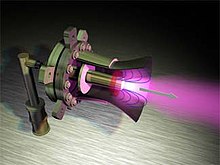Magnetoplasmadynamic thruster
Generally, a gaseous material is ionized and fed into an acceleration chamber, where the magnetic and electric fields are created using a power source.
[1] According to Edgar Choueiri magnetoplasmadynamic thrusters have input power 100–500 kilowatts, exhaust velocity 15–60 kilometers per second, thrust 2.5–25 newtons and efficiency 40–60 percent.
MPD technology also has the potential for thrust levels of up to 200 newtons (N) (45 lbF ), by far the highest for any form of electric propulsion, and nearly as high as many interplanetary chemical rockets.
[citation needed] This would allow use of electric propulsion on missions which require quick delta-v maneuvers (such as capturing into orbit around another planet), but with many times greater fuel efficiency.
[4] MPD thruster technology has been explored academically, but commercial interest has been low due to several remaining problems.
A project to produce a space-going nuclear reactor designed to generate 600 kilowatts of electrical power began in 1963 and ran for most of the 1960s in the USSR.
This plan utilizes 5 200 kW free electron lasers at 0.84 micrometres with adaptive optics on the ground to beam power to the MPD-powered spacecraft, where it is converted to electricity by GaAs photovoltaic panels.
[11] Another problem with MPD technology has been the degradation of cathodes due to evaporation driven by high current densities (in excess of 100 A/cm2).


